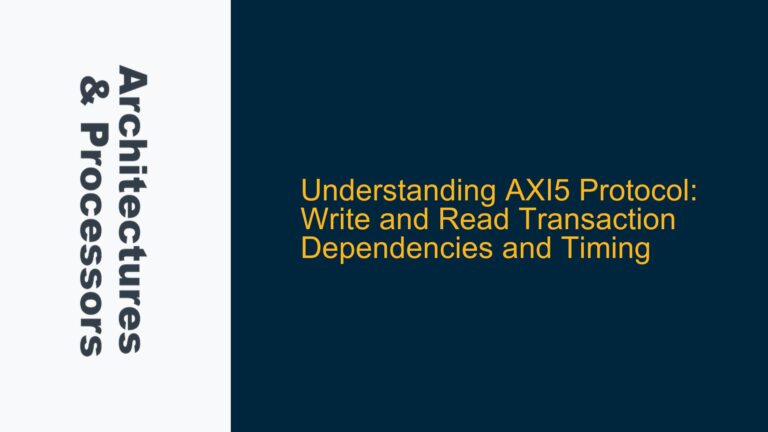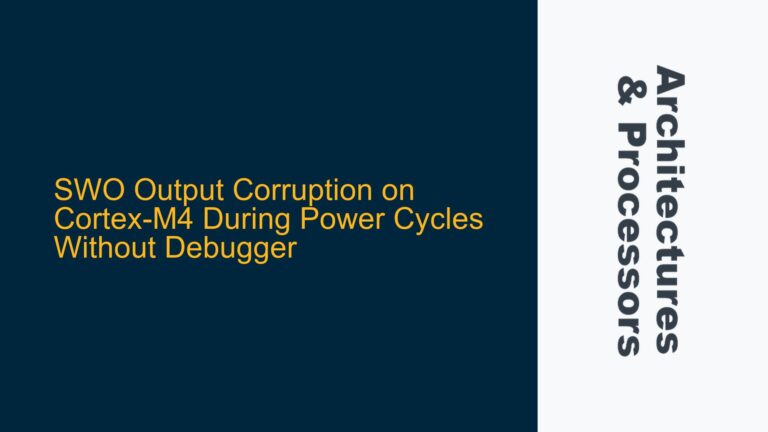EXC_RETURN Bit[4] and Floating Point Context Saving
The ARM Cortex-M4 processor, particularly the M4F variant with a Floating Point Unit (FPU), handles the saving of the floating point context during exception handling through a combination of hardware mechanisms and configuration bits. The EXC_RETURN value, which is loaded into the Link Register (LR) upon exception entry, plays a critical role in determining how the processor manages the floating point stack. Specifically, bit[4] of EXC_RETURN indicates whether the floating point context (registers S0-S15 and FPSCR) has been saved onto the stack. Understanding when and how this bit is cleared is crucial for developers working with real-time systems, where deterministic behavior and efficient stack usage are paramount.
The floating point context saving mechanism is controlled by three key configuration bits: LSPEN (Lazy Stacking Enable), ASPEN (Automatic State Preservation Enable), and FPCA (Floating Point Context Active). These bits influence whether the floating point registers are pushed onto the stack during exception entry and under what conditions. The interaction between these bits and the EXC_RETURN value determines the behavior of the processor, and misconfiguration can lead to inconsistent state preservation, stack corruption, or inefficient use of memory.
LSPEN, ASPEN, and FPCA Configuration Bits
The LSPEN bit, located in the FPU Lazy Stacking Control Register, enables or disables the lazy stacking mechanism. When LSPEN is set to 1, the processor employs lazy stacking, which means that the floating point registers are only saved if they are used within the exception handler. This optimization reduces the overhead of saving and restoring the floating point context when it is not needed. However, if LSPEN is cleared, the processor will always save the floating point registers upon exception entry, regardless of whether they are used in the handler.
The ASPEN bit, also located in the FPU Lazy Stacking Control Register, determines whether the floating point context is automatically preserved during exception handling. When ASPEN is set to 1 and the FPCA bit in the CONTROL register is also set to 1, the processor will push the floating point registers onto the stack upon exception entry. If ASPEN is cleared, the floating point context is not saved, even if FPCA is set. This configuration is useful in scenarios where the floating point unit is not used, or where the developer wants to manually manage the floating point context.
The FPCA bit, located in the CONTROL register, indicates whether the floating point context is active. When FPCA is set to 1, it means that the floating point unit has been used in the current execution context, and the floating point registers may need to be saved during exception handling. If FPCA is cleared, the floating point context is not active, and the registers are not saved, regardless of the state of LSPEN and ASPEN.
The relationship between these bits and the EXC_RETURN value is as follows: When an exception occurs, the processor checks the state of ASPEN and FPCA. If both bits are set to 1, the processor will push the floating point registers onto the stack and set bit[4] of EXC_RETURN to 0, indicating that the floating point context has been saved. If either ASPEN or FPCA is cleared, the floating point context is not saved, and bit[4] of EXC_RETURN remains set to 1.
Debugging and Resolving Floating Point Context Save Issues
When debugging issues related to floating point context saving on the ARM Cortex-M4, it is essential to verify the configuration of the LSPEN, ASPEN, and FPCA bits. Incorrect settings can lead to unexpected behavior, such as the floating point context not being saved when required, or unnecessary stack usage due to excessive context saving.
To troubleshoot these issues, start by examining the state of the FPU Lazy Stacking Control Register and the CONTROL register. Ensure that the LSPEN and ASPEN bits are configured according to the requirements of your application. If lazy stacking is desired, set LSPEN to 1. If automatic state preservation is required, set ASPEN to 1. Additionally, verify that the FPCA bit is set correctly based on whether the floating point unit is being used in the current execution context.
Next, inspect the EXC_RETURN value upon exception entry. If bit[4] is set to 1, it indicates that the floating point context was not saved. This could be due to either ASPEN or FPCA being cleared. If bit[4] is cleared, the floating point context was saved, and you can proceed to verify that the saved context is correctly restored upon exception return.
In cases where the floating point context is not being saved as expected, consider the following steps:
-
Enable Automatic State Preservation: Set the ASPEN bit to 1 in the FPU Lazy Stacking Control Register. This ensures that the floating point context is automatically preserved during exception handling, provided that the FPCA bit is also set.
-
Verify FPCA State: Ensure that the FPCA bit in the CONTROL register is set to 1 if the floating point unit is being used. This bit indicates that the floating point context is active and should be saved during exception handling.
-
Disable Lazy Stacking if Necessary: If lazy stacking is causing issues, such as the floating point context not being saved when needed, consider clearing the LSPEN bit. This will force the processor to always save the floating point context upon exception entry, regardless of whether it is used in the handler.
-
Check Exception Handler Usage: If lazy stacking is enabled, ensure that the exception handler does not use the floating point unit unless absolutely necessary. Using the floating point unit in the handler will trigger the lazy stacking mechanism, causing the floating point context to be saved.
-
Inspect Stack Usage: Monitor the stack usage to ensure that the floating point context is being saved and restored correctly. Incorrect stack management can lead to stack corruption or inefficient use of memory.
By carefully configuring the LSPEN, ASPEN, and FPCA bits and verifying the EXC_RETURN value, you can ensure that the floating point context is managed correctly during exception handling on the ARM Cortex-M4. This will help you avoid issues related to inconsistent state preservation and optimize the performance of your embedded system.
Implementing Best Practices for Floating Point Context Management
To achieve reliable and efficient floating point context management on the ARM Cortex-M4, it is important to follow best practices that take into account the specific requirements of your application. These practices include:
-
Configuring LSPEN and ASPEN Appropriately: Choose the settings for LSPEN and ASPEN based on whether lazy stacking and automatic state preservation are needed. For example, if your application frequently uses the floating point unit in exception handlers, enabling lazy stacking can reduce overhead. However, if deterministic behavior is more important, consider disabling lazy stacking.
-
Monitoring FPCA State: Ensure that the FPCA bit is set correctly based on the usage of the floating point unit. This bit should be set to 1 if the floating point unit is active and cleared if it is not. Incorrectly setting this bit can lead to unnecessary context saving or failure to save the context when required.
-
Optimizing Exception Handlers: Minimize the use of the floating point unit in exception handlers to reduce the overhead of context saving and restoring. If the floating point unit must be used, ensure that the handler is designed to work efficiently with the lazy stacking mechanism.
-
Testing and Validation: Thoroughly test the behavior of the floating point context saving mechanism under different scenarios, including nested exceptions and high-priority interrupts. This will help you identify any issues related to context management and ensure that the system behaves as expected.
-
Documenting Configuration Settings: Clearly document the configuration of the LSPEN, ASPEN, and FPCA bits, as well as the expected behavior of the floating point context saving mechanism. This documentation will be valuable for debugging and maintaining the system.
By following these best practices, you can ensure that the floating point context is managed efficiently and reliably on the ARM Cortex-M4, leading to a more robust and performant embedded system.






